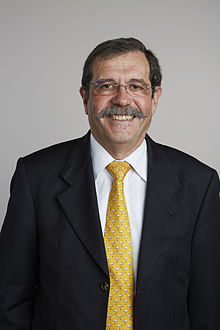Alain Aspect
| Alain Aspect | |
|---|---|

Alain Aspect in 2015, portrait via the Royal Society
|
|
| Born |
15 June 1947 Agen, France |
| Residence | France |
| Nationality | French |
| Fields | Physicist |
| Institutions |
Institut d'Optique École Polytechnique Centre national de la recherche scientifique |
| Alma mater | École Normale Supérieure de Cachan (E.N.S., 1965) |
| Known for | Bell test experiments |
| Notable awards |
|
|
Website www |
|
Alain Aspect (French: [aspɛ]; born 15 June 1947) is a French physicist noted for his experimental work on quantum entanglement.
Aspect is a graduate of the École Normale Supérieure de Cachan (ENS Cachan). He passed the 'agrégation' in physics in 1969 and received his master's degree from Université d'Orsay. He then did his national service, teaching for three years in Cameroon.
In the early 1980s, while working on his PhD thesis from the lesser academic rank of lecturer, he performed the elusive "Bell test experiments" that showed that Albert Einstein, Boris Podolsky and Nathan Rosen's reductio ad absurdum of quantum mechanics, namely that it implied 'ghostly action at a distance', did in fact appear to be realised when two particles were separated by an arbitrarily large distance (see EPR paradox). A correlation between their wave functions remained, as they were once part of the same wave-function that was not disturbed before one of the child particles was measured.
Aspect also received an Honorary Doctorate from Heriot-Watt University in 2008
If quantum theory is correct, the determination of an axis direction for the polarization measurement of one photon, forcing the wave function to 'collapse' onto that axis, will influence the measurement of its twin. This influence occurs despite any experimenters not knowing which axes have been chosen by their distant colleagues, and at distances that disallow any communication between the two photons, even at the speed of light.
...
Wikipedia
